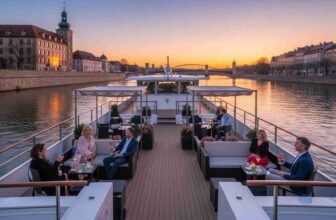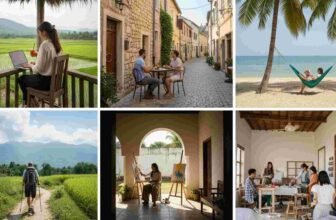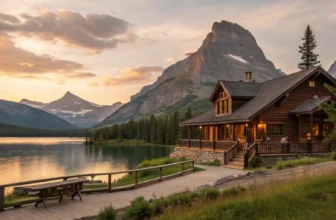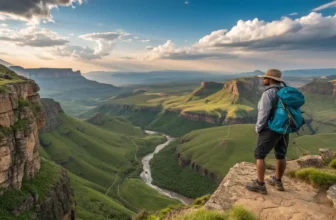

Imagine the scent of fresh bread wafting from a tucked-away bakery, the sound of a distant bell echoing through cobblestone streets, and the warmth of a local’s smile as they share the secrets of a place few have discovered.
In a world where most travelers flock to the same well-worn spots, there’s something truly magical about stepping off the beaten path. This is your invitation to uncover Europe’s hidden villages and cities, where history, culture, and authenticity live in harmony. Join us on a journey that promises not just to explore—but to experience Europe in its purest, most unforgettable form.
1. Vlkolínec, Slovakia

Tucked high in the foothills of the Veľká Fatra Mountain Range, Vlkolínec feels like a whispered secret of Central Europe: stepping off the winding mountain path, you arrive in a settlement of timber-log houses whose roofs are still shingled in wood, and whose narrow yards betray a way of life unchanged for centuries. The hush is palpable—no rush of cars, barely a hum of modern life—so as you wander past the 1770 wooden belfry (still standing guard) you can almost hear the history of shepherds, woodcutters and families living in harmony with the forest.
Inside one of the preserved farmhouses you feel the weight of time: worn wooden beams, tools hanging where they have hung for a century, the simple corridor (“pitvor”) flanked by the main chamber and the barn. It’s a living museum—except people still live here, keeping the delicate balance of heritage and everyday life.
Practical Information:
- Peak / Off-peak seasons & weather insights: The best time is late spring to early autumn—May through September offer mild weather; winter brings deep snow and can make access difficult. Because the village is at altitude (~700 – 800 m) the air stays cool even in summer.
- Best ways to reach & explore: From the nearby town of Ružomberok drive or take a bus to Biely Potok and then walk ~45 minutes along a marked trail to Vlkolínec.Explore on foot—no big tour groups or buses inside the narrow lanes.
- Ideal duration of visit: Half-day if pressed; a full day lets you wander the village thoroughly, linger in a café and hike the adjacent trails.
- Must-try local experiences: Visit the farmhouse museum house No. 16/17, stroll the two-row street pattern and discover the long yard-layout, hear the wooden bell tower chime; enjoy local shepherd cheese (“oštiepok”) available nearby.
- Budget considerations: Entry to the expositions is minimal (€2 for adult, parking €1 as per visitor review) and accommodation in nearby towns is modest.
- Cultural etiquette tips: Respect the fact that it is a living village—keep voices low, don’t wander into private yards, ask permission for interior photography.
- Photography opportunities: Early-morning light on the colorful log houses, the wooden belfry in mist, mountain vistas behind the village, and detail shots of the shingled roofs and carved woodwork.
2. Bardejov, Slovakia

Wandering into Bardejov is like entering a medieval storybook the broad rectangular town square surrounded by vividly coloured Gothic and Renaissance burgher houses, the basilica rising with its spire and carved altars, the town walls and bastions quietly reminding you of an era when this was a free royal town defending its markets and merchants.
As you move from the central square into the narrow lanes of the old fortified town, the pace slows and the atmosphere deepens. In the late afternoon light I wandered past the Basilica of St Egidius (dating back to the 15th century) and found myself imagining the guilds, merchants and craftspeople who once bustled through these streets, trading in cloth and metal and goods bound for far-off destinations.
Practical Information:
- Peak / Off-peak seasons & weather insights: Late spring to early autumn offers comfortable weather; winters are cold with snow—if you visit then, dress warmly. The climate is continental.
- Best ways to reach & explore: Bardejov is accessible by car from Košice or Poprad; regular buses link from regional hubs. Within the town centre walking is best to soak in the old town.
- Ideal duration of visit: A full day gives you time to explore the square, the fortifications, the Jewish quarter, and nearby spa town Bardejovské Kúpele. Half-day if you’re short on time.
- Must-try local experiences: Visit the Basilica of St Egidius with its 11 Late Gothic altars. Walk the town walls and explore the old Jewish suburb with its synagogue and history.
- Budget considerations: Accommodation and food in Bardejov are relatively affordable compared to major tourist hubs.
- Cultural etiquette tips: When entering religious buildings, dress modestly. In the Jewish quarter, quiet respect is appreciated for the historic synagogue.
- Photography opportunities: The main square at golden hour, rooftops and fortification towers from the ramparts, detail of carved altars inside the basilica, and snapshots of locals in traditional markets.
3. Kazimierz Dolny, Poland

On the eastern bank of the mighty Vistula River, Kazimierz Dolny exudes the elegant stillness of a town long ago removed from the rush of commerce. Its golden age came in the 16th-17th centuries when the river trade hum was strong, and after that the slowdown worked in its favour—leaving behind richly preserved Renaissance architecture, absorbing artists and tranquil pauses in time.
Strolling through the market square as morning mist lifts off the river, I was struck by how artistry seemed woven into every step—galleries tucked into archways, sculptors outside their studios, colours tinkling gently in the early light. There’s a creative energy here, discreet but alive, as though every surface invites you to pause and reflect. A little further down by the river, I found the old granaries—silent witnesses to the grain trade of old—with their stout forms and weather-softened bricks giving character to the riverbank.
Practical Information:
- Peak / Off-peak seasons & weather insights: Summer (June–August) is lively and warm; spring and early autumn are quieter and pleasant. Winters are cold.
- Best ways to reach & explore: From Lublin region, drive or take a bus to Kazimierz Dolny; the town is easily walkable once you arrive. Bikes or scooters can be rented by the river.
- Ideal duration of visit: A full day or overnight stay is ideal to soak in both art and riverbank atmosphere; one night lets you enjoy sunset and morning light.
- Must-try local experiences: Visit the market square and explore the galleries, rent a bike or scooter for a riverbank ride, and admire the old granaries along the Vistula.
- Budget considerations: While more popular than tiny villages, it remains more affordable than major tourist hubs in Poland; meals, lodging modestly priced.
- Cultural etiquette tips: Respect the arts community—ask before photographing inside galleries; when walking along quieter residential streets be mindful of local homes.
- Photography opportunities: Sunrise or sunset over the Vistula and granaries, the colourful facades of the market square, artists at work in open studios, reflections on the river.
4. Sibiu, Romania

In the heart of Transylvania lies Sibiu—nicknamed “The Town with Eyes” for the distinctive dormer windows that gaze down on its cobblestoned streets—and when you arrive in its Old Town you feel the layered echoes of Saxon settlers, Hungarian, Romanian and German influences all folded into one.
I remember standing in the Grand Square (Piaţa Mare) as twilight fell: café lights flicked on, shadows climbed the towers of the Council Tower (13th century), and I could almost hear the city breathing. Upstairs in one rooftop café I watched the rooftops and thought about how this city has been both frontier and cultural centre for centuries—its medieval walls still visible in parts, its vibe both grounded and subtly cosmopolitan.
Practical Information:
- Peak / Off-peak seasons & weather insights: Spring to early autumn (April–October) gives best conditions; winters are long, cold and snowy due to proximity to the Carpathians.
- Best ways to reach & explore: Fly into Sibiu International Airport or reach by train/bus from Bucharest/Cluj; once in town, explore by foot—Old Town is highly walkable; bike rentals also available.
- Ideal duration of visit: 1–2 full days recommended; extra time lets you venture into nearby hills or villages.
- Must-try local experiences: Climb the Clock Tower for panoramic views, wander the Bridge of Lies, sit in the Grand Square for café time, explore the ethnic Saxon and Romanian architecture.
- Budget considerations: Prices are reasonable by European standards—accommodation and meals can be very good value, especially off-peak.
- Cultural etiquette tips: When entering churches or museums, modest dress is advisable; locals appreciate polite greetings in Romanian (“Bună ziua”) even if you switch to English.
- Photography opportunities: Rooftop views of “eyes” dormers, the Bridge of Lies at dusk, the Grand Square with the Council Tower lit at night, mountain views framing the city.
5. Le Chambon‑sur‑Lignon, France

Perched in the high plateaux of the Haute-Loire region in France, Le Chambon-sur-Lignon exudes the kind of quiet dignity that stays with you: stone houses clustered around a gentle river, mountain ridges undulating beyond, and a community that carries a story of courage and welcome during the darkest of times.
Walking into town, I encountered the hush of early morning mist rising off the Lignon du Velay river, the sound of water over rocks, and the chiming of church bells across the valley. The sense of place felt profound—not merely picturesque, but rooted in history and human connection.
Practical Information:
- Peak / Off-peak seasons & weather insights: Summer offers mild mountain climate; winters can bring snow and shorter daylight in the high-altitude setting.
- Best ways to reach & explore: Reach by car or regional train + bus from central France (Lyon / Clermont-Ferrand area). Once in town explore on foot or rent a bike to ride the plateaux.
- Ideal duration of visit: A one-night stay gives you the sunset and morning; two nights lets you hike the surrounding hills and visit local memorials.
- Must-try local experiences: Short hike to the ridge above town for broad views, visit the local museum/memorial dedicated to the wartime rescue efforts, enjoy a dinner in a local mountain tavern tasting lentils from the Velay region.
- Budget considerations: Being less tourist-crowded than major French destinations, lodging and meals tend to be fair value; still, remote location may mean fewer budget options.
- Cultural etiquette tips: Respect memorial sites and local stories; French greetings matter (“Bonjour”, “Merci”); in smaller villages speak quietly in public spaces.
- Photography opportunities: Morning light on the river and stone houses, panoramic views of the plateau, memorial plaques and local architecture, intimate portraits of village life.
6. Metaxades, Greece

Rather than focusing on grand scenery, Metaxades invites you into the quiet rhythms of a border village in the Evros region — where history, culture and the land converge quietly. Imagine stopping at the weekly bazaar under oak trees, hearing the local folk songs still sung, discovering a chapel that once functioned as a “secret school” during Ottoman times.
Picture arriving just before dusk, walking through the low‑hills and walnut‑groves, pausing at the small café where older locals speak of the days when this village stood at the edge of empires and borders. The air smells of wood‑smoke and lentils simmering; the silence is punctuated only by a distant bell.
Practical Information:
- Getting there & exploring: Reach via the regional road from Didymoteicho (approx 28 km) then roam on foot through the village and into surrounding oak‑forest trails.
- Recommended stay duration: 1 night if you’re tight on time; ideally 2 nights to experience sunrise, village life and the forest fringe.
- Local experience highlight: Join the Wednesday bazaar, trek to the hilltop pavilion above the forest, listen to live Rhodopean folk in the evening.
- Budget tip: Lodging is modest; eateries are village‑priced; transport cost slightly higher due to remote location.
- Cultural etiquette: As a border settlement with deep history, approach with quiet respect; modest dress in local chapels; greet with a friendly “Kaliméra”.
- Photo moments: Early‑morning mist drifting over stone houses, the oak‑forest paths, the small church stairway built “semi‑underground”.
7. Shiroka Laka, Bulgaria

Beyond its scenic charm, Shiroka Laka is a living cradle of Rhodope bagpipe (kaba gaida) culture and spectacular masks & costumes of the kukeri carnival on the first Sunday of March.
Imagine arriving on that March Sunday you’re walking narrow stone streets, almost being nudged aside by masked figures in garlic‑and‑pepper‑decorated costumes, deep bass of bagpipes echoing in the mountain air. This isn’t just tourist spectacle—it’s a ritual rooted in seasonal rhythms, apexing a moment when local folklore moves from hearth to street.
Practical Information:
- Best times & climate glimpse: High mountain altitude (~1,206 m) means winters are snowy, springs crisp; best visits in late spring or early autumn when colours and light align.
- Access & discovery: Located 23 km from Smolyan, reachable by local mountain roads; once there, stroll the clustered tiered houses, visit the old school & church.
- Ideal visit length: 1 day minimum to absorb village + music + architecture; 2 days if you want to explore surrounding Rhodope trails.
- Local experience to pursue: Attend a live kaba gaida session, visit during the kukeri festival, walk past the 19th‑century Church of Holy Mother‑of‑God built in 38 days (legend says).
- Budget note: Accommodation small‑scale, food simple mountain fare; fewer tourists mean better value.
- Etiquette tip: Respect the music and traditions; ask before photographing costumes/festival groups; shoes off when entering older homes/church.
- Photo moments: Late‑afternoon sun on the tiers of white‑washed houses and stone‑roofs; masked kukeri dancers in shadowy corridors; snow‑laden river views in winter.
8. Hunawihr, France

Nestled in the vineyards of the Alsace wine route, Hunawihr is lesser‑traveler‑crowded than its neighbouring tourist hubs, offering undisturbed vine‑terraced landscapes and a beautifully preserved fortified church.
Envision sipping a glass of Riesling at a tiny wine‑bar overlooking rows of grapevines set into pink‑sandstone hills beyond the village church. A vineyard worker waves from the slope above; a church bell peals. The air smells of ripe grapes and autumn mist.
Practical Information:
- Season notes: Visit in autumn (September–October) to see vine‑leaves turning gold and enjoy harvest‑time energy; summer is nice, spring a little early for vines.
- Getting there & roaming: Located on the Alsace Wine Route (Route des Vins d’Alsace); best by car or bike from Ribeauvillé or Colmar. The village itself is compact and best explored on foot.
- Time to spend: Half‑day works if you’re passing through; full day if you combine vineyard walks and wine tastings.
- Highlight local experiences: Visit the fortified church of St‑Jacques, attend a vineyard tour with a local winemaker, enjoy an outdoor picnic at sunset among vines.
- Budget framing: Wine tastings may cost modest euros; village lodging tends toward mid‑tier because of its location in a prized wine region.
- Cultural courtesy: When visiting vineyards ask before wandering through vines; speak a few French phrases (bonjour, merci) to locals.
- Photo gems: Vine‑lined lanes curving above village rooftops, interior of the fortified church, panoramic shot of vineyards + Vosges foothills.
9. Alpbach, Austria

While many know Alpbach for its “most beautiful village” title in Austria, the lesser‑told story is of how its uniform Tyrolean wooden architecture and blanket of alpine flowers preserve a community aesthetic deeply rooted in tradition rather than tourism hype.
Picture arriving in the early morning, crisp mountain air, walking out from the Hotel into an alpine meadow blanketed in white wildflowers, then turning down into the village where every chalet façade is flower‑filled geraniums, and locals stop to smile as you pass. You’re part of scenery rather than just viewing it.
Practical Information:
- Seasonal snapshot: Summer (June–September) is lush and ideal for hiking; winter offers snow‑sports but different mood and more tourists.
- Access & exploring: Reachable from Zurich or Innsbruck airports, then by car or regional bus into the Alpbachtal valley. Village easily explored on foot; take cable‑car up for alpine views.
- Ideal duration: Overnight stay recommended to enjoy sunrise over the valley; 2 nights if you want hikes or ski‑day.
- Local experiences: Hike “Nature Trail 5” above the village, join a traditional Tyrolean evening with live accordion and spoken‑word tales, stroll the flower‑lined Hauptstraße.
- Budget considerations: More premium than remote villages due to alpine infrastructure; look for guesthouse deals off‑peak.
- Etiquette tips: In alpine regions dress in layers; in the village respect quiet hours (especially at night). A simple “Grüß Gott” (hello) goes a long way.
- Photography opportunities: Sweeping valley views at dawn, flower‑filled wooden chalets, snow‑capped peaks framing the village in winter.
10. Lavenham, England

the medieval charm of Lavenham is well known, but what often gets overlooked is its story of prosperity and sharp decline—the reason so many of its timber‑framed houses remain untouched and so atmospheric today.
Early evening, you walk along Shilling Street as the light spills across half‑timbered buildings leaning slightly at odd angles (due to timber warping when wealth dried up). A local in the pub recounts how the town once exported broadcloth to Russia, then faded. You feel the echoes of medieval merchant ambition mixed with quiet present‑day ease.
Practical Information:
- Best times & climate: Spring through early autumn offer mild weather; English countryside charm is especially strong in October.
- Access & strolling: Located in Suffolk, easily accessible by car from London / Cambridge; once there wander the High Street, visit the Guildhall (1529).
- Recommended stay: Half‑day works for a town‑stop; overnight stay letsou absorb dawn light in the narrow alleys and quiet morning church bells.
- Highlight experiences: Visit the Wool Hall (1464), step into the “Crooked House” at 7–9 High Street, enjoy tea in a 15th‑century merchant home.
- Budget snapshot: Being a tourist‑friendly English village, lodging can vary; mid‑tier pubs with rooms are good value; meals standard UK pricing.
- Etiquette tips: Respect residential areas; village streets are narrow—quiet voices after 9 pm appreciated.
- Photo moments: Dawn light on half‑timbered facades, the Guildhall in market square, crooked house angles against a grey English sky.
11. Gerberoy, France

Nestled among the Oise countryside, Gerberoy may seem as though it stepped right out of a fairytale—its wisteria‑covered houses and cobbled lanes create a sense of suspended time. Its claim to fame? A lifetime of passionate restoration by one man, and the result is a village that feels lovingly curated rather than mass‑visited. You’ll wander past pastel façades, climb the ramparts for views over green fields, and perhaps find yourself at a small niche café tucked behind a climb of stairs where only locals sip their café crème in peace.
aim for early spring when the wisteria reaches full bloom (but just before it draws larger tourist numbers) and slip into a local boulangerie for the “tarte aux fraises” (which, in Gerberoy, tastes like sunshine).
Practical Information:
- When to visit: Bloom‑season late April–early May for flowers; autumn for golden foliage.
- How to get there: Rent a car from Paris (~1.5 h) or take train to Beauvais + taxi/ride.
- Ideal stay: Half‑day or overnight if you prefer sunset‑streets and morning light.
- Unique experience: Join the villagers on the terrace of the café church‑square for a simple local wine and watch day fade into dusk.
- Budget note: Accommodation modest but fewer budget guesthouses—book ahead.
- Etiquette: Speak softly in public lanes; greetings in French go a long way.
- Photo‑moment: Back‑lit wisteria over stone roofs at golden hour; up‑close on old carved doorways.
12. Bad Gastein, Austria

High in the steep valley of the Hohe Tauern, Bad Gastein blends old‑world spa grandeur with rugged alpine wildness in a way that surprises. Beneath the Belle Époque façades lie thermal springs, forest trails and waterfalls that roar between town houses. The village isn’t just a pretty winter scene—it’s a full‑fledged nature retreat with timeless style.
I arrived at dusk when steam rose from the thermal river and the hotel lights began to glow through the mist. I took the cable‑car up to the Stubnerkogel ridge, looking down on the town’s roofs that seemed to cascade down the mountain into the waterfall‑gorge. The blend of elegance and wildness stayed with me well into my sleep.
Practical Information:
- When to go: Summer (June‑Sept) for hiking and thermal baths; winter for skiing but more tourists.
- Access: Train from Salzburg to Bad Gastein (~1.5 hours) + town is walkable.
- Stay: 1–2 nights ideal to blend spa/rest and nature hikes.
- Special experience: Visit the Felsentherme spa built into the mountain, then step outside to a forest trail.
- Budget: Alpine resort pricing moderate; look for guesthouses outside centre.
- Etiquette: In thermal areas bring swim‑cap or towel as required; respect quiet zones.
- Photo op: The waterfall slicing through town houses; sunrise ridge vistas; steam over hot‑springs at dusk.
13. Opatija, Croatia

Often glossed over in favour of Croatia’s island‑beaches, Opatija offers a different slice of the Adriatic: stately villas, mellow promenades and a quiet elegance that feels historic yet very much alive. The old Austro‑Hungarian resort mood lingers, but with locals going about their day outside café windows and fewer cruise‑bus stops.
On a golden afternoon I strolled the Lungomare promenade, sea‑breeze in my hair, palms overhead, the pastel façade of villas behind me. Splashes of locals walking dogs, art‑galleries tucked into side‑streets, and at a café I found a small group of fishermen repairing nets under a tree. That mixture of resort‑glamour and real life made me pause.
Practical Information:
- Best time: Late spring or early autumn for mild weather and fewer crowds.
- Getting there: From Rijeka airport (~30 min by taxi) or drive along coastal road; explore by foot or bike.
- Time needed: A full day is ample; stay overnight for sunset and early morning tranquillity.
- Must‑do: Walk the 12 km Lungomare, pause at the “Girl with the Seagull” statue, visit the villa‑museum of Ika.
- Cost: Mid‑range resort pricing but shoulder‑season offers good deals.
- Respectful behaviour: Dress smart‑casual at dusk; tipping natural but not extravagant.
- Photography: The waterfront palms and pastel villas at dawn; side‑street reflections at dusk; coastal cliff‑walk views.
14. Tirana, Albania

This is not the “tourist trap” capital—far from it. Tirana is full of contradictions: communist‑era bunkers turned art‑spaces, bright murals covering dull façades, cafés buzzing with students, and mountains rising suddenly just beyond the urban sprawl. It’s raw, changing, vibrant.
I arrived after dusk, walked up to a rooftop bar overlooking the city lights and the mountains beyond. The next morning I found myself in Blloku district among pink pastel buildings, scooter‑zipping locals, coffee in hand. A voice beside me said: “You’ll only really get Tirana if you accept the noise, the mix, the unfinished.” That stuck.
Practical Information:
- Best window: Late April–June or September for warm but not stifling weather.
- How to access: Fly into Tirana airport (TIA), use bus or taxi to city centre; local buses or walk in town.
- Time: 2–3 days ideal to absorb city & mountain‑edge feel.
- Local experience: Visit Bunk’Art 1/2 to understand history, then switch to late‑night cocktail in Blloku.
- Budget: Very affordable compared to Western Europe; use cash for smaller shops.
- Etiquette: Learn “Faleminderit” (thanks), modest dress in mosques; engage with locals—they’re welcoming.
- Photo gems: Murals across the city, skyline with Dajti mountain backdrop, late‑evening café lights in Blloku.
15. Cadiz, Spain

Cadiz is one of Europe’s oldest port cities, yet often overlooked in favour of Andalusian heavyweights like Seville or Granada. Here the Atlantic ripples against ancient walls, fishermen mend nets beside baroque churches, and you’ll find street‑daylife that feels real and rooted.
On a breezy evening I walked along the sea wall as pelicans soared overhead and an old man sat playing flamenco guitar by the steps. I joined for a moment—listening, watching—realising that the city’s authenticity lay not just in monuments but in how life carried on in the streets.
Practical Information:
- Visit in spring (March‑May) or autumn (Sept) when the weather is warm but less crowded.
- Reach from Seville or Malaga via train or bus (approx 1.5–2 h).
- Suggested stay: 2 nights to enjoy old town, beach and local vibes.
- Experience: Sunset drink at La Caleta beach, wander the narrow streets of Barrio del Populo, listen for the dusk church bell rhythm.
- Budget: Moderate Spanish city pricing; avoid beachfront tourist restaurants—opt for inner lanes.
- Etiquette: Late dinners normal (after 9 pm); greet with “Hola” and “Buenas tardes”.
- Photo shots: Dawn over the cathedral and harbour, fishermen’s boats bobbing at inner‑marina, golden sunset at La Caleta.
16. Lavenham, England

In the heart of Suffolk lies Lavenham—a timber‑framed merchant town whose crooked houses and sleepy lanes whisper of former cloth industry riches. What sets it apart is how intact it has remained: you wander through alleys where 15th‑century merchants once counted bolts of cloth, and the modern visitor almost doesn’t intrude.
I visited at dawn, stepping into the mist along the High Street. A solo jogger nodded, a cat perched on a windowsill. The half‑timbered facades curved slightly, the air smelled of the damp English countryside, and I realised: this was not about sightseeing, it was about being present in a place that time allowed to breathe.
Practical Information:
- Prime time: Late spring or early autumn for mild weather and golden light.
- Access: From London by train to Sudbury + taxi/bus; car gives flexibility.
- Stay: Overnight if you want dawn & dusk light; day‑visit works if staying nearby.
- Experience: Tea in a 15th‑century inn, browse local artisan shops, walk to the surrounding farmland at sunset.
- Budget: Moderate UK village prices but fewer tourists keep value high.
- Courtesy: Lower your voice in narrow lanes; many houses are private homes.
- Photography: Dawn mist on crooked facades, Guildhall viewed from the church tower, timber‑framed detail under evening light.
17. Staufen im Breisgau, Germany
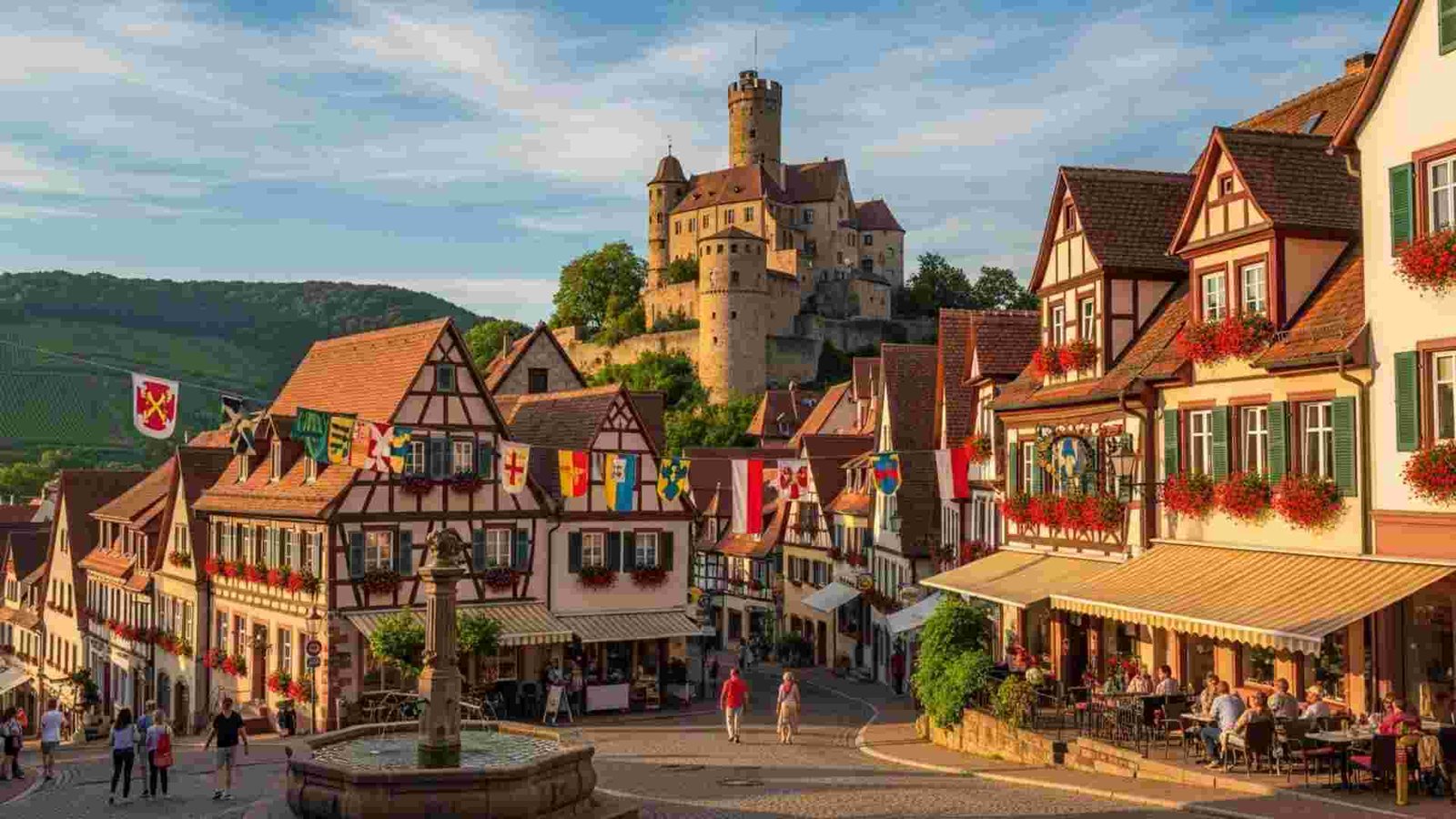
Towering vineyards climb above this medieval town in the Black Forest region, and legend says that the alchemist Faustus made his Faustian deal here—giving the town a rich layer of myth. Yet rather than opt for big‑tourist draws, Staufen offers drystone lanes, shaded beer‑gardens, and views over the Rhine plain that feel generous.
On a cloud‑wrapped morning I climbed the Schlossberg path above the town, passed grapevines heavy with dew, reached the look‑out and looked out across the patchwork of fields chasing the horizon. Below, the steeple of St Martins church peeked between rooftops; all around birds called. It felt like a moment held in amber.
Practical Information:
- Ideal seasons: Spring for blossoms; early autumn for harvest; winter for quiet.
- How to get there: Take train to Staufen (from Freiburg), walk into town centre or rent bike.
- Stay: 1–2 nights recommended to absorb vineyard‑scape and town walk.
- Local experience: Participate in a “Wein‑Wanderung” (wine‑walking hike) from town into vineyards.
- Budget: Germany rural pricing; vineyards may charge tasting fees.
- Etiquette: In wine taverns greet with a nod and an “Ein Prosit”; vineyards expect quiet respect.
- Photo opportunities: Vine‑terraced slopes with medieval town below; sunset over Rhine valley from hill‑top; autumn grapes heavy on vine.
18. Borghetto sul Mincio, Italy

Often overshadowed by the nearby Lake Garda, this hamlet is the kind of place you’ll stumble into and feel pleased you did. Built around the rushing waters of the Mincio river, stone mills, old bridges and water‑wheels set the rhythm here.
I arrived just after the morning mist lifted over the river, walked the mill‑path beside the water, heard the blades turning, frogs chirping. I sat on a bench beside a rushing waterfall, the voice of the water dominating the scene. No crowds, just water, stone and sky. Then I had lunch on a terrace by the bridge as dappled light danced through leaves.
Practical Information:
- Best window: May–June or early Autumn for mild weather and fewer visitors.
- How to get there: From Verona or Milan train to Peschiera del Garda, then bus or bike ~10 km to village.
- Time: Half‑day fine; full day if you want river‑walks and relaxed lunch.
- Experience: Morning mill‑walk, lunch by the Mincio waterfalls, afternoon boutique‑soap shopping in the old town.
- Budget: Very affordable for Italy; lunch by the river nicer value than Lake Garda resorts.
- Local manners: On riverside paths, avoid loud music; respect property boundaries near historic mills.
- Photo shot: Mill‑wheel against flowing water, bridge‑arch framing the village across the river, late‑afternoon light dancing on stone façades.
Conclusion:
Exploring Europe beyond the typical tourist destinations reveals a rich tapestry of authentic villages and cities, each brimming with its own unique charm and cultural significance. From the misty streets of Vlkolínec to the lively markets of Bardejov, these hidden gems offer a deeper, more personal connection to Europe’s history and people. Whether you’re seeking tranquility in a mountain village or the quiet beauty of coastal towns, these lesser-known locations provide unforgettable experiences that truly capture the essence of the continent. Embrace the journey off the beaten path—these towns promise the authentic European escape you’ve been longing for.


